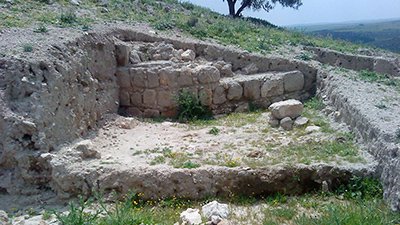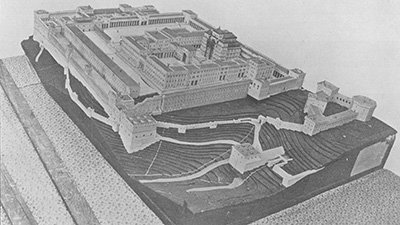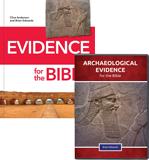
The Destruction of Sodom and the Future Judgment
The reasons for God’s judgment against the “great sinners” of Sodom and how its destruction points to a greater future punishment to come.
The names Sodom and Gomorrah are infamous for God’s judgment upon the wickedness of the people who lived in those cities (cf. Genesis 13:13).1 Sodom is seen as the epitome of wickedness and an expression of God’s wrath (Jeremiah 23:14).
Although critical scholars, because of their naturalistic mindset, view the account of Sodom’s destruction as just another legend or folk tale, the Bible clearly teaches it was a genuine historical event. Just as Jesus and the apostle Peter pointed to the flood as a guarantee of future judgment, so they both also pointed to God’s judgment of Sodom by fire as a guarantee of future judgment:
Just as it was in the days of Noah, so will it be in the days of the Son of Man. They were eating and drinking and marrying and being given in marriage, until the day when Noah entered the ark, and the flood came and destroyed them all. Likewise, just as it was in the days of Lot—they were eating and drinking, buying and selling, planting and building, but on the day when Lot went out from Sodom, fire and sulfur rained from heaven and destroyed them all—so will it be on the day when the Son of Man is revealed. On that day, let the one who is on the housetop, with his goods in the house, not come down to take them away, and likewise let the one who is in the field not turn back. Remember Lot’s wife. (Luke 17:26–32)
[I]f he did not spare the ancient world, but preserved Noah, a herald of righteousness, with seven others, when he brought a flood upon the world of the ungodly; if by turning the cities of Sodom and Gomorrah to ashes he condemned them to extinction, making them an example of what is going to happen to the ungodly; and if he rescued righteous Lot, greatly distressed by the sensual conduct of the wicked (for as that righteous man lived among them day after day, he was tormenting his righteous soul over their lawless deeds that he saw and heard); then the Lord knows how to rescue the godly from trials, and to keep the unrighteous under punishment until the day of judgment … (2 Peter 2:5–9)
Just as with the days before the flood, Jesus spoke of the days before the destruction of Sodom as a time when people were indifferent and solely concerned with the things of this life.
Just as with the days before the flood, Jesus spoke of the days before the destruction of Sodom as a time when people were indifferent and solely concerned with the things of this life: eating and drinking, buying and selling, planting and building. In other words, people were caught up with material things of life, which caused them to have a lack of concern for the things of God. Then the destruction by fire and sulfur came quickly and unexpectedly, destroying them all.
Likewise, when Peter spoke of the judgment that took place at Sodom and Gomorrah, turning it to ashes, it was to foreshadow the coming future eschatological judgment by fire (cf. 2 Peter 3:7). This final eternal judgment, however, will not engulf everybody. Just as God preserved Noah and seven others in the judgment of the flood, and Lot in the judgment of Sodom, he will also spare the godly while judging and destroying the ungodly (2 Peter 2:9).
Given the significance that both the Old and New Testament place on the destruction of Sodom as a warning of future judgment, it is important to understand this event.
Why Was Sodom Destroyed?
In Genesis 13, because Abram (Abraham) and his nephew Lot have become affluent in flocks and herds, strife breaks out between their herdsmen as the land can no longer sustain all their possessions (Genesis 13:6–7). Abraham, therefore, proposes that he and Lot separate, and he gives Lot the choice of the whole land (Genesis 13:9). Lot chose “all the Jordan Valley” (Genesis 13:11) because it was “well-watered everywhere like the garden of the Lord, like the land of Egypt …” (Genesis 13:10). Abraham settled in the land of Canaan, by the Oaks of Mamre at Hebron (Genesis 13:18), but Lot journeyed eastward and “settled among the cities of the valley and moved his tent as far as Sodom” (Genesis 13:12).
Although Lot was not living in Sodom at this point, it did not take long for Lot to move into that wicked city (Genesis 14:12). It seems that Lot did not influence Sodom, but rather Sodom influenced Lot. From the time that Lot left Abraham to his living in Sodom and its destruction, a little over 20 years had passed.2
In Genesis 18, the LORD appears to Abraham and announces his intention that Sodom is to be destroyed because its sin is “very grave” (Genesis 18:20). The men of Sodom were previously described as “wicked, great sinners against the LORD” (Genesis 13:13). The latter term “wicked” (raʿ) is also used to describe the people at the time of the flood (Genesis 6:5, 8:21) and indicates that the people of Sodom’s “sins deserved the same catastrophic response from God.”3 But what was the wickedness of Sodom?
The main issue that Genesis 19 focuses on is the fact that all the men of Sodom want to “know” (yādaʿ4) the angelical visitors: in other words, to have sexual relations with them (Genesis 19:4–5; cf. Genesis 4:1). It is no wonder that the sin of Sodom was described as “very grave” as the men of Sodom had “unnatural desires” (Jude 7) wanting to commit a shameless act (cf. Romans 1:26–27).
Nevertheless, it is important to realize that Sodom was guilty of many other sins than homosexuality.
Nevertheless, it is important to realize that Sodom was guilty of many other sins than homosexuality. In later biblical history, the prophets compared the social injustices committed by God’s chosen people Israel/Judah to the people of Sodom: gluttony, prosperous ease, not aiding the poor, haughtiness, injustice (Isaiah 1:17, 3:9), adultery, lying, and an unwillingness to repent (Jeremiah 23:14).
The prophet Ezekiel also points out that the guilt of Sodom was: “pride, excess of food, and prosperous ease, but did not aid the poor and needy. They were haughty and did an abomination before me” (Ezekiel 16:49–50). Although some argue that Ezekiel does not mention homosexual behavior as one of the sins of Sodom, this overlooks the fact that the Hebrew word abomination (tôʿēbâ) refers to sexual immorality, specifically homosexual intercourse proscribed in Leviticus 18:22; 20:13 (cf. 1 Corinthians 6:9).
In the end, God justly judged Sodom and Gomorrah not only because of its wicked behavior, but because ten righteous people could not be found there (Genesis 18:23–32). Even though he had lived in Sodom for just over 20 years, it seems righteous Lot (2 Peter 2:7–8) had no impact upon the city of Sodom.
The Destruction of Sodom
The destruction of Sodom (c. 2067 BC)5, takes place in Genesis 19 after Lot, his wife,6 and two daughters, with the help of the two angels, escape Sodom and flee to Zoar (Genesis 19:20–22).
The sun had risen on the earth when Lot came to Zoar. Then the LORD rained on Sodom and Gomorrah sulfur and fire from the LORD out of heaven. And he overthrew those cities, and all the valley, and all the inhabitants of the cities, and what grew on the ground. (Genesis 19:23–25)
Moses uses the language of the flood in Genesis 6–7 to describe the destruction of Sodom. Just as God sent the waters of the flood that “rained” (mamṭîr, Genesis 7:4) down on the earth in the days of Noah so he “rained” (himṭîr) down sulfur and fire on Sodom and Gomorrah in a fiery deluge. The fiery deluge “destroyed” (šaḥēt) Sodom, as the earth was destroyed by water at the time of the flood (see Genesis 13:10, 19:29, cf. 6:13, 17).7
Through the raining down of sulfur and fire, God “overthrew” (hăpōk) Sodom, the valley, all the inhabitants, and everything that grew on the ground. Everything was destroyed: it was a total catastrophe. The Greek translation of the Old Testament (LXX) translates the Hebrew word hăpōk as katestrephen, which is the source for the word catastrophe. The same word is used in the New Testament when Jesus cleanses the temple and “overturned [katestrephen] the tables of the money-changers” (Matthew 21:12).
Through the raining down of sulfur and fire, God “overthrew” (hăpōk) Sodom, the valley, all the inhabitants, and everything that grew on the ground. Everything was destroyed: it was a total catastrophe.
The apostle Peter’s description of Sodom’s “extinction” (katastrophe) fits well with the judgment brought upon the city that turned it to ashes (see 2 Peter 2:6). After God overthrew Sodom, the whole land was burned so that nothing could grow, and no person would dwell in it again (see Deuteronomy 29:23; Isaiah 13:19–20; Jeremiah 49:18, 50:40).
Even though Lot is considered righteous, his life is a lesson for Christians who are caught up with the things of this world. In the end, what had attracted Lot to Sodom (the beautiful land, Genesis 13:10) was gone. Remember Lot started his life living under the blessing of his relative Abraham (Genesis 12:2–3), but because “he saw” the beauty of the Jordan valley, he moved towards Sodom and later became a resident of that wicked city (Genesis 13:10–12, 14:12). Not only did he “linger” on the day of its destruction, escaping only by the mercy of God (Genesis 19:16), but he lost his wife (Genesis 19:26) and sons-in-law (Genesis 19:14). Not only that, but Lot’s only offspring (Moab and Ammon) were the result of his daughters sexually exploiting him (Genesis 19:33–36),8 while his last years were spent living in a mountain cave like a recluse (Genesis 19:30).
“Written for our Instruction”9
Jude uses the catastrophic judgment that came upon Sodom and Gomorrah as an “example” for the punishment of the ungodly, which is characterized as “eternal fire” (pyros aiōniou, cf. Matthew 25:46).
[J]ust as Sodom and Gomorrah and the surrounding cities, which likewise indulged in sexual immorality and pursued unnatural desire, serve as an example by undergoing a punishment of eternal fire. (Jude 7)
The knowledge that there is a future judgment to come should motivate us to warn those who are still in their sins that the only way to escape the coming judgment is by trusting in the Lord Jesus Christ, the one who has taken the judgment of sinners upon himself so that we can live righteous lives in this present evil age (cf. 1 Peter 2:24; Galatians 1:4).
Footnotes
- The Bible gives greater prominence to Sodom than to Gomorrah. Gomorrah is always paired with Sodom (Genesis 10:19, 13:10, 14:2, 8, 10, 11, 18:20, 19:24, 28; Deuteronomy 29:23, 32:32; Isaiah 1:9, 13:19; Jeremiah 23:14, 49:18, 50:40; Amos 4:11; Zephaniah 2:9; Matthew 10:15; Romans 9:29; 2 Peter 2:6; Jude 1:7), whereas Sodom is mentioned by itself numerous times (Genesis 13:12, 13; Isaiah 3:9; Lamentations 4;6; Ezekiel 16:46; Matthew 11:23-25; Luke 11:12, 17:29; Revelation 11:8).
- Using the chronological information in Genesis, it is possible to calculate the 20 years. Abraham was 75 when he left Haran (Genesis 12:4) and was 85 when Ishmael was conceived (Genesis 16:3). Sodom was destroyed at around the time of the conception of Isaac, when Abraham was 99 (Genesis 17:1; 21:5).
- Kenneth Mathews, Genesis 11:27-50:26, The New American Commentary (Nashville, TN: B&H Publishing Group, 2005), 137.
- The Hebrew verb yādaʿ is often used in a sexual sense (6 of these times are in Genesis alone 4:1, 17, 25, 19:8, 24:16, 38:26). It is used elsewhere in the Old Testament to describe sexual activity (Numbers 31:17, 18, 35; Judges 11:39, 19:22, 25, 21:11; 1 Samuel 1:19; 1 Kings 1:4).
- How do we get the date for Sodom and Gomorrah’s destruction? Solomon’s temple was built in 967 BC, and the Israelite Exodus from Egypt was 480 years earlier in 1446 BC (1 Kings 6:1; cf. Judges 11:26). Israel sojourned in Egypt for 430 years (Exodus 12:40; cf. Acts 13:17-20), and Jacob was 130 years old when he entered Egypt (Genesis 47:9). Isaac was 60 years old when Jacob was born (Genesis 25:26). Then with almost a year of pregnancy for Sarah with Isaac, the destruction of Sodom and Gomorrah was around 2067. For a defense of this date see Simon Turpin, “Biblical Problems with Identifying Tall el-Hammam as Sodom,” Answers Research Journal 14 (2021): 45–59. Or in approximately 1897 BC, per Ussher, using a short sojourn timeline, as described in James Ussher, The Annals of the World, translated by Larry and Marion Pierce (Master Books, Green Forest, AR, 2003), 26.
- Lot’s wife did not make it to Zoar as she disobeyed the angels’ warning and looked back to Sodom and was thus turned into a pillar of salt (Genesis 19:26; cf. Luke 17:32).
- שַׁחֵ֣ת “destroy”: this root, apart from 38:9, is used in Genesis only for the destruction of the flood and of these cities.” Gordon Wenham, Genesis 1-15: Word Biblical Commentary. Vol. 1 (Waco, Texas: Thomas Nelson, 1987), 297.
- The narrative points out twice that Lot “did not know” that his daughters had sexually exploited him (Genesis 19:33, 35).
- Romans 15:4
Recommended Resources

Answers in Genesis is an apologetics ministry, dedicated to helping Christians defend their faith and proclaim the good news of Jesus Christ.
- Customer Service 800.778.3390
- © 2024 Answers in Genesis







